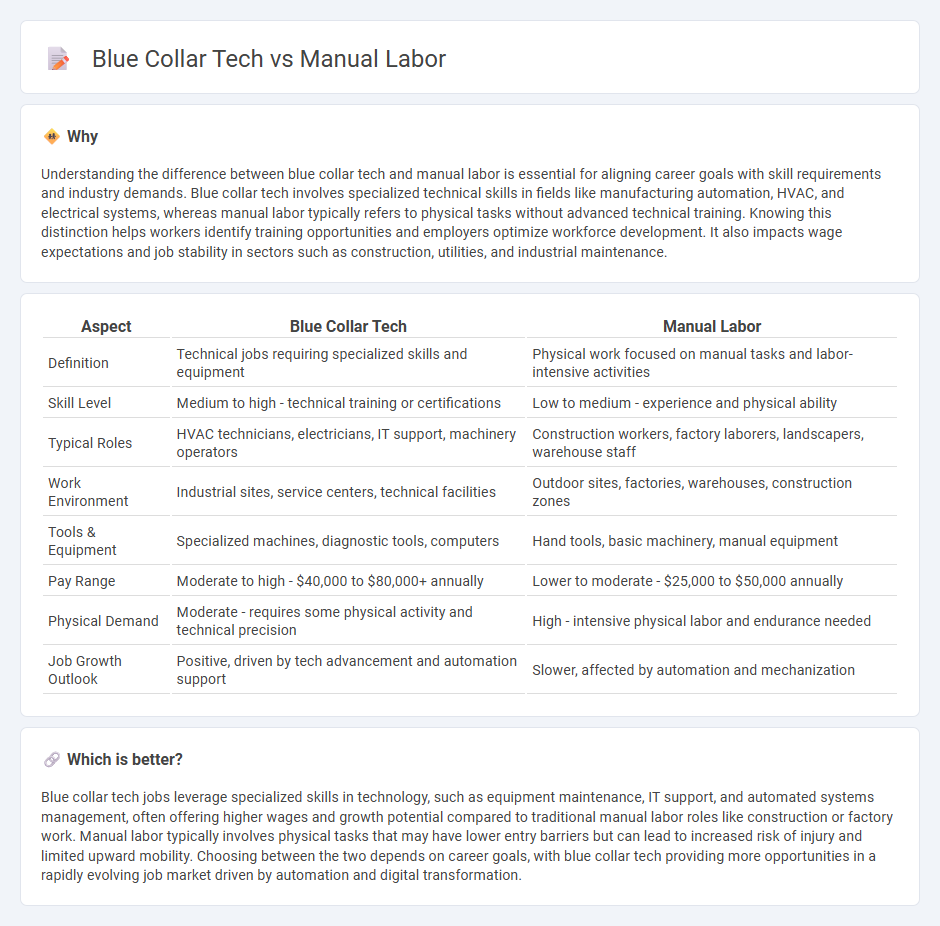
Blue collar tech jobs blend advanced technology with traditional skilled trades, offering higher wages and career growth compared to manual labor's physically intensive roles. Automation and digital tools enhance efficiency and safety in tech-driven blue collar positions, transforming industries like manufacturing and construction. Explore how evolving employment trends are reshaping the future of blue collar work and manual labor.
Why it is important
Understanding the difference between blue collar tech and manual labor is essential for aligning career goals with skill requirements and industry demands. Blue collar tech involves specialized technical skills in fields like manufacturing automation, HVAC, and electrical systems, whereas manual labor typically refers to physical tasks without advanced technical training. Knowing this distinction helps workers identify training opportunities and employers optimize workforce development. It also impacts wage expectations and job stability in sectors such as construction, utilities, and industrial maintenance.
Comparison Table
| Aspect | Blue Collar Tech | Manual Labor |
|---|---|---|
| Definition | Technical jobs requiring specialized skills and equipment | Physical work focused on manual tasks and labor-intensive activities |
| Skill Level | Medium to high - technical training or certifications | Low to medium - experience and physical ability |
| Typical Roles | HVAC technicians, electricians, IT support, machinery operators | Construction workers, factory laborers, landscapers, warehouse staff |
| Work Environment | Industrial sites, service centers, technical facilities | Outdoor sites, factories, warehouses, construction zones |
| Tools & Equipment | Specialized machines, diagnostic tools, computers | Hand tools, basic machinery, manual equipment |
| Pay Range | Moderate to high - $40,000 to $80,000+ annually | Lower to moderate - $25,000 to $50,000 annually |
| Physical Demand | Moderate - requires some physical activity and technical precision | High - intensive physical labor and endurance needed |
| Job Growth Outlook | Positive, driven by tech advancement and automation support | Slower, affected by automation and mechanization |
Which is better?
Blue collar tech jobs leverage specialized skills in technology, such as equipment maintenance, IT support, and automated systems management, often offering higher wages and growth potential compared to traditional manual labor roles like construction or factory work. Manual labor typically involves physical tasks that may have lower entry barriers but can lead to increased risk of injury and limited upward mobility. Choosing between the two depends on career goals, with blue collar tech providing more opportunities in a rapidly evolving job market driven by automation and digital transformation.
Connection
Blue collar tech integrates advanced digital tools and automation to enhance manual labor efficiency, directly impacting traditional industries like construction, manufacturing, and logistics. This connection fosters a hybrid workforce where skilled technicians operate and maintain machinery, while manual laborers engage in physically demanding tasks, creating a synergy that boosts productivity and reduces workplace injuries. Companies investing in blue collar tech report higher output levels and improved job satisfaction as workers adapt to technology-driven processes.
Key Terms
Skill Level
Manual labor often relies on physical strength and repetitive tasks requiring basic to moderate skill levels, whereas blue collar tech roles demand specialized technical knowledge, problem-solving abilities, and continuous skill development to operate advanced machinery or digital tools. Blue collar technicians typically undergo formal training or certifications in areas such as HVAC systems, automotive diagnostics, or industrial automation, reflecting a higher skill level relevant to evolving technological landscapes. Explore how the skill requirements shape career opportunities and advancements in these fields.
Automation
Manual labor jobs traditionally involve physical tasks such as construction, maintenance, and factory work, often requiring significant human effort without extensive technological integration. Blue collar tech roles incorporate automation and advanced machinery, utilizing robotics, AI, and IoT to enhance productivity and safety while reducing repetitive strain on workers. Explore how automation is transforming blue collar tech and reshaping the future of manual labor careers.
Wages
Wages in manual labor jobs typically range from $25,000 to $45,000 annually, depending on skill level and industry, while blue collar tech positions offer higher average salaries between $50,000 and $80,000 due to specialized technical skills. Trades such as HVAC technicians, electricians, and equipment operators often experience wage growth linked to certifications and experience. Explore detailed salary comparisons and career paths to understand the financial advantages of blue collar tech roles.
Source and External Links
Benefits of Manual Labor: Preparing You For Your Career - Manual labor is defined as work involving physical effort, typically requiring using one's muscles, often in fields such as construction, agriculture, manufacturing, and more, with workers commonly called blue-collar workers.
17 Manual Labor Jobs - Manual labor careers include a wide range of jobs that involve physical work, from entry-level to highly skilled positions requiring training or certifications, such as housekeepers, construction workers, landscapers, and emergency medical technicians.
Manual labour - Wikipedia - Manual labor is physical work done by humans with the hands or muscles, historically associated with low social status and class discrimination, and contrasted with mechanized or animal labor.
 dowidth.com
dowidth.com